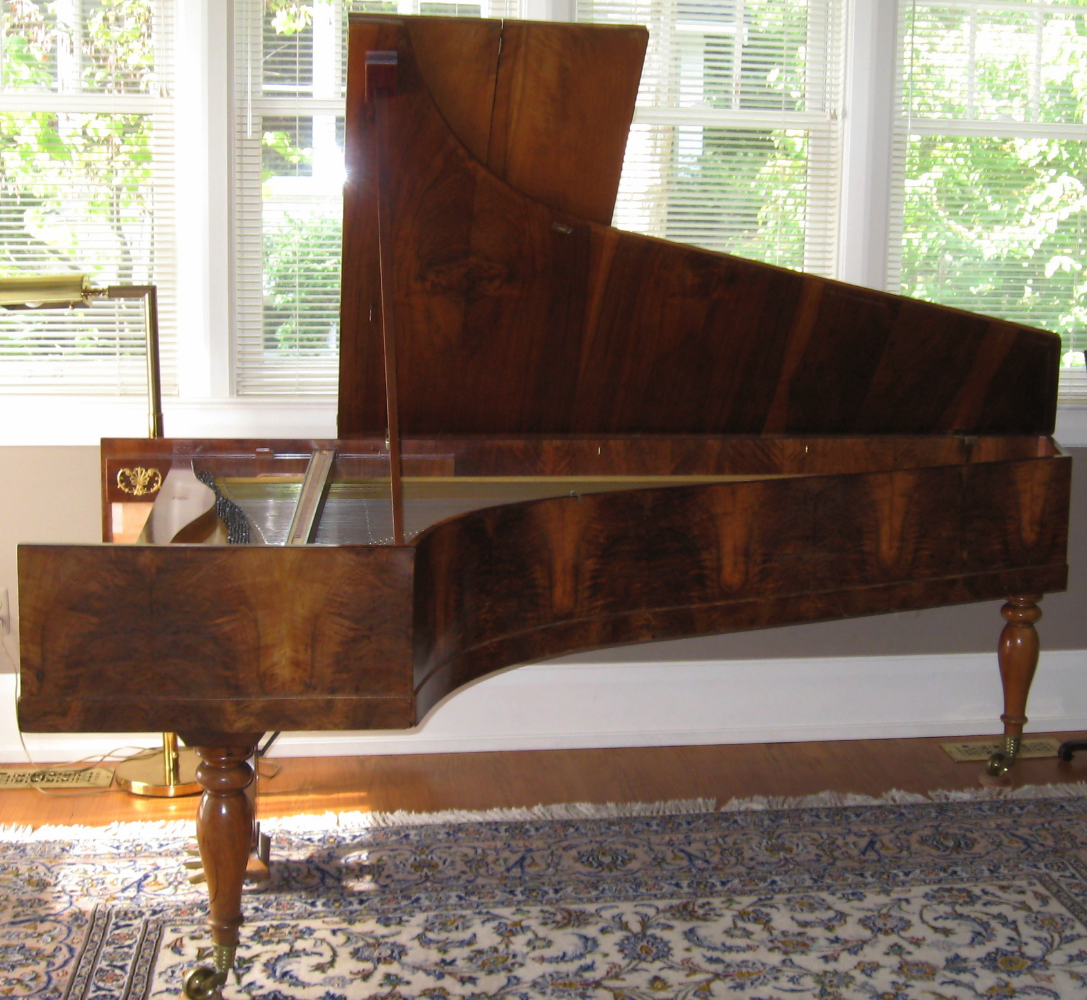The Above Photo is of the Conrad Graf Fortepiano from 1835 in Ann Arbor, Michigan, the instrument I base my 6 ½ Octave Fortepianos On
FORTEPIANOS
The Fortepiano Pictured below is My Opus 350
Made after the 1726 Cristofori which I Modified in the
Spirit of Silbermann to be 5 Octaves and 2 Notes FF’g’’’
with a Knee Lever for the Dampers.
Over the last 30 years I have regularly made both five octave and six and one half octave fortepianos and altogether have made more than 21 fortepianos. The models were selected on the basis of how well, in my judgment, the original maker solved all of the problems of physical design, functional design, and acoustical design. The action had to work smoothly and reliably under every manner of touch. It had to feel light yet secure. It had to function silently. It had to feel positive yet supple. The instrument had to hold its tuning for an extended period of time without being overbuilt. It had to be easy to get the action in and out of the keywell. It had to be easy to regulate and adjust; and it had to hold a regulation within a given season. It had to sound firm and resonant without sounding harsh or dull. It had to have an extremely full yet singing treble, a colorful and full middle range, and a solid, sonorous bass. It had to be loud enough for concerto playing yet be able to play at a pppp range with relative ease and still have that level of volume to project to the end of a large room.
This FortePiano pictured above is my Opus 419 made after the 1796 Walther in 2009
Fortepiano - after the 1796 Walther now in Nuremberg.
Walther has carefully solved all the problems of making a piano of this size. The only limitation with this design is that it can't play the Waldstein sonata. To remedy this, I have added four notes to the top (as Walther himself later did) to make that possible.
5 ⅓ octaves from FF to a''', bichord from FF - a', trichord from b flat' on up, strung in iron.; ebony naturals with bone topped sharps, and two knee levers (moderator and dampers).
This Fortepiano is the 1835 Graf in Ann Arbor, Michigan on which I base my 6 ½ Octave pianos. (shown without the keyboard)
Fortepiano - after Conrad Graf, 1835, now in Ann Arbor, Michigan.
6 ½ octaves from CC to g'''', trichord throughout except for 6 notes that are double strung in the deep bass, treble is strung in iron, brass in the bass. With pedal lyre and three pedals (una chorda, moderator, and damper), bone naturals and ebony topped sharps.
PianoForte after Cristofori Based on the 1726 Cristofori now in Leipzig.
5 ½ octaves from FF to g''', bichord throughtout and strung in brass; ebony naturals with bone topped sharps, and one knee lever for the dampers. For Una Chorda the keyboard is manually moved for that effect.
The Sound Sample below is of my first Cristofori type fortepiano Opus 342 made in 1999
The Sound Sample below is of my second Cristofori type fortepiano Opus 350 made in 2000
In this perfomance below of Beethoven's Moonlight Sonata-first movement, you will hear the piece played exactly as Beethoven indicated. That is, senza sordini and una chorda throughout.
I have made five of this type of piano, like that shown in the picture above, in the last years and find that they are more rewarding to build than the Viennese type of piano—a wholly unexpected discovery—for a variety of reasons...all of them musical. The light and resilient parchment hammers make as pure a sound as possible on a piano which translates into a high degree of color or timbre flexibility for the player. The sound of brass wires is enchanting, which makes improvising on this piano easy. The action likes to play softly as you will have heard in the recording of the Moonlight Sonata of Beethoven, yet the light construction of the corpus gives the tone great resonance which makes for intensely sweet softs. The very light leather dampers silence the strings in such a way as to make using a lever to raise the dampers largely unnecessary. Still, I provide a knee lever for that purpose to make the performance of the later literature possible.
It is interesting to me how, after Bartolomeo Cristofori perfected his design for the piano, almost no piano makers understood his designs...not Silbermann, not Broadwood, not Pleyel nor Erard. The single maker who eventually figured out the piano itself but still did not understand the action design was Stein, who invented his own action design to compensate for what he failed to understand in the Cristofori action. And then, when Conrad Graf came along he finally understood what the piano was all about in the same way as Cristofori but stuck instead to perfecting the Viennese Fortepiano. No one developed Cristofori's concept. I have thought this to be unfortunate so I tried my hand at making a Cristofori based 6 octave piano. What you can see and hear below is the result of my understanding of Cristofori's genius.
Until I built this 6 Octave Cristofori Fortepiano, no one had ever attempted to take Cristofori's design to its maximum limits. It is double strung in Brass. The two pedals work the Dampers and the Una chorda keyboard shift. This piano is my Opus 363 made in 2003 and finally completed and sold in 2007 to the Technical University in Trondheim, Norway. The recordings above were made by Marianne Ploger on this piano just before it was shipped to Norway.
Fortepiano after Walther. This is an EE - a'''' expanded version of the original in Nuremberg.









